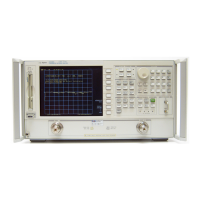Service Guide 4-11
8719ET/20ET/22ET Start Troubleshooting Here
8719ES/20ES/22ES Step 3. GPIB Systems Check
RF Network Analyzers
If Using a Plotter or Printer
1. Ensure that the plotter or printer is set up correctly:
• Power is on.
• Pens and paper loaded.
• Pinch wheels are down.
• Some plotters need to have P1 and P2 positions set.
2. Press and then or .
• If the result is a copy of the analyzer display, the printing/plotting features are
functional in the analyzer. Continue with “Troubleshooting Systems with Multiple
Peripherals” and “Troubleshooting Systems with Controllers” on page 4-12, or go to
“Step 4. Faulty Group Isolation” on page 4-13.
• If the result is not a copy of the analyzer display, refer to Chapter 6 , “Digital Control
Troubleshooting.”
If Using an External Disk Drive
1. Select the external disk drive. Press .
2. Verify that the address is set correctly. Press
.
3. Ensure that the disk drive is set up correctly:
• Power is on.
• An initialized disk in the correct drive.
• Correct disk unit number and volume number. (Press to access the softkeys
that display the numbers; default is 0 for both.)
• With hard disk (Winchester) drives, make sure the configuration switch is properly
set (see drive manual).
4. Press . Then press
.
• If the resultant trace starts at 1 GHz, the GPIB system is functional in the analyzer.
Continue with “Troubleshooting Systems with Multiple Peripherals” and
“Troubleshooting Systems with Controllers” on page 4-12, or go to “Step 4. Faulty
Group Isolation” on page 4-13.
• If the resultant trace does not start at 1 GHz, suspect the GPIB function of the
analyzer. Refer to Chapter 6 , “Digital Control Troubleshooting.”
Copy
Save/Recall
Local
Local
Start 1 G/n
Preset

